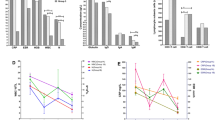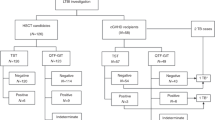Summary:
Hyperinfection with strongyloides stercolis occurs in the setting of chronic strongyloides infection in conjunction with immune suppression. Although malnutrition remains the major secondary cause worldwide in the developed world, iatrogenic immue suppression is an important precipitant. Autologous stem cell transplantation recipients are significantly immunocompromised albeit temporarily. Despite the increasing use of haemopoetic stem cell transplantation, hyperinfection with strongyloides has rarely been reported. We describe two cases of patients transplanted with chronic strongyloidiasis. In one case eradication therapy was given prior to the transplant which was uncomplicated. In the second case strongyloidiasis was diagnosed post transplant which was complicated by infection and respiratory compromise. Fatal hyperinfection subsequently developed after corticosteroid therapy was started for a disease progression in the CNS.
This is a preview of subscription content, access via your institution
Access options
Subscribe to this journal
Receive 12 print issues and online access
$259.00 per year
only $21.58 per issue
Buy this article
- Purchase on Springer Link
- Instant access to full article PDF
Prices may be subject to local taxes which are calculated during checkout

Similar content being viewed by others
References
Genta RM . Global prevalence of strongyloidiasis: critical review with epidemiologic insights into the prevention of disseminated disease. Rev Infect Dis 2001; 11: 755–767.
Neva FA . Biology and immunology of human strongyloidiasis. J Infect Dis 1986; 153: 397–406.
Genta RM, Miles P, Fields K . Opportunistic Strongyloides stercoralis infection in lymphoma patients. Report of a case and review of the literature. Cancer 1989; 63: 1407–1411.
DeVault GAJ, King JW, Rohr MS et al. Opportunistic infections with Strongyloides stercoralis in renal transplantation. Rev Infect Dis 1990; 12: 653–671.
Aydin H, Doppl W, Battmann A et al. Opportunistic strongyloides stercoralis hyperinfection in lymphoma patients undergoing chemotherapy and/or radiotherapy – report of a case and review of the literature. Acta Oncol 1994; 33: 78–80.
Fontanet AL, Sahlu T, Rinke de Wit T et al. Epidemiology of infections with intestinal parasites and human immunodeficiency virus (HIV) among sugar-estate residents in Ethiopia. Ann Trop Med Parasitol 2000; 94: 269–278.
Nolan TJ, Schad GA . Tacrolimus allows autoinfective development of the parasitic nematode Strongyloides stercoralis. Transplantation 1996; 67: 1038.
Palau LA, Pankey GA . Strongyloides hyperinfection in a renal transplant recipient receiving cyclosporine: possible Strongyloides stercoralis transmission by kidney transplant. Am J Trop Med Hyg 1997; 57: 413–415.
McLauchlan PE, Roberts HC, Chappell LH . Mode of action of cyclosporin A against Hymenolepis microstoma (Cestoda): relationship between cyclophilin binding and drug-induced damage. Parasitology 2000; 121: 661–670.
Armson A, Cunningham GA, Grubb WB et al. Murine strongyloidiasis: the effects of cyclosporin A and thiabendazole administered singly and in combination. Int J Parasitol 1995; 25: 533–535.
Rotman HL, Yutanawiboonchai W, Brigandi RA et al. Strongyloides stercoralis: Eosinophil dependant immune-mediated killing of third stage larvae in BALB/cByJ mice. Exp Parasitol 1996; 82: 267–278.
De Broski HR, Lee JJ, Lee NA et al. Role of IL-5 in inate and adaptive immunity to larval Strongyloides stercoralis in mice. J Immunol 2000; 165: 4544–4551.
Liu LX, Weller PF . Strongyloidiasis and other intestinal nematode infections. Infect Dis Clin N Am 1993; 7: 655–682.
Cook GA, Rodriguez H, Silva H et al. Adult respiratory distress secondary to strongyloidiasis. Chest 1987; 92: 1115–1116.
Setoyama M, Fukumaru S, Takasaki T et al. SLE with death from acute massive pulmonary hemorrhage caused by disseminated strongyloidiasis. Scand J Rheumatol 1997; 26: 389–391.
Genta RM . Predictive value of an enzyme-linked immunosorbent assay (ELISA) for the serodiagnosis of strongyloidiasis. Am J Clin Pathol 1988; 89: 391–394.
Nucci M, Portugal R, Pulcheri W et al. Frequency of intestinal parasites in adult cancer patients in Mexico. Clin Infect Dis 1995; 21: 675–677.
Author information
Authors and Affiliations
Corresponding author
Rights and permissions
About this article
Cite this article
Orlent, H., Crawley, C., Cwynarski, K. et al. Strongyloidiasis pre and post autologous peripheral blood stem cell transplantation. Bone Marrow Transplant 32, 115–117 (2003). https://doi.org/10.1038/sj.bmt.1704104
Received:
Accepted:
Published:
Issue Date:
DOI: https://doi.org/10.1038/sj.bmt.1704104
Keywords
This article is cited by
-
Severe strongyloidiasis: a systematic review of case reports
BMC Infectious Diseases (2013)
-
Strongyloides stercoralis hyperinfection after allogeneic stem cell transplantation
Bone Marrow Transplantation (2009)
-
An unusual cause of alveolar hemorrhage post hematopoietic stem cell transplantation: A case report
BMC Cancer (2006)
-
Hookworm infection of sigmoid colon masquerading as graft-versus-host disease in an allogeneic stem cell transplant recipient after donor lymphocyte infusion for refractory acute promyelocytic leukemia
Bone Marrow Transplantation (2006)
-
Strongyloidiasis pre and post autologous peripheral blood stem cell transplantation
Bone Marrow Transplantation (2004)



